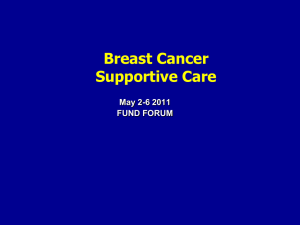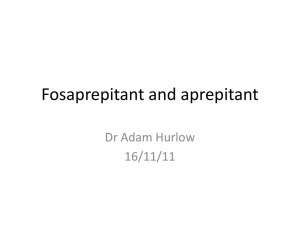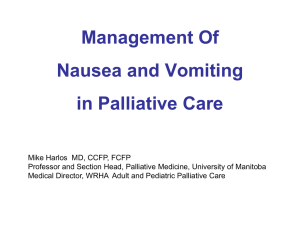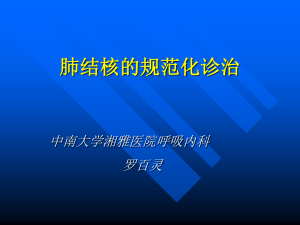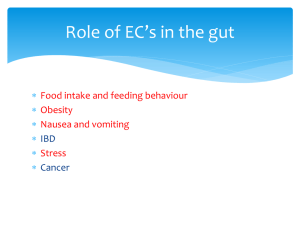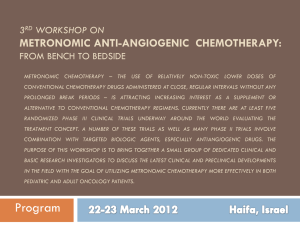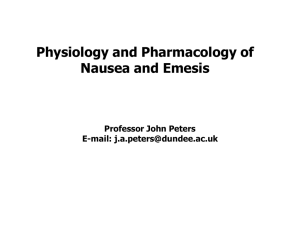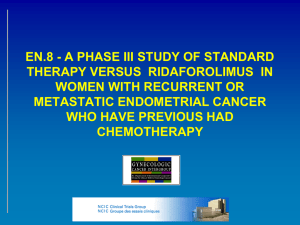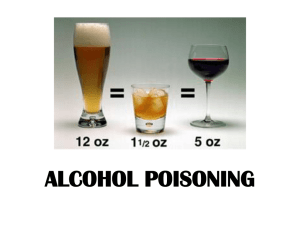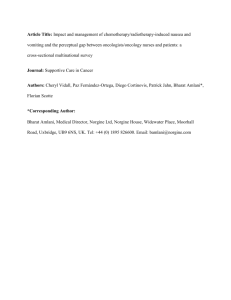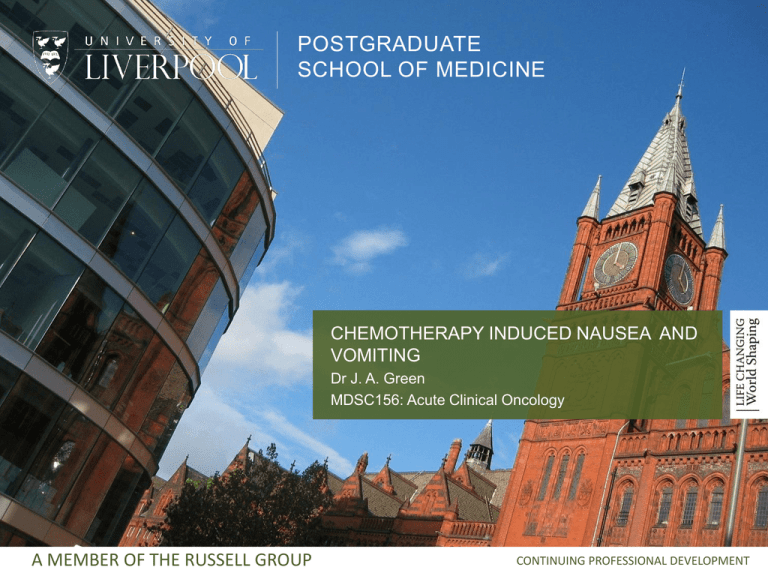
Chemotherapy Induced Nausea and Vomiting
POSTGRADUATE
SCHOOL OF MEDICINE
1
CHEMOTHERAPY INDUCED NAUSEA AND
VOMITING
Dr J. A. Green
MDSC156: Acute Clinical Oncology
A MEMBER OF THE RUSSELL GROUP
CONTINUING PROFESSIONAL DEVELOPMENT
Chemotherapy Induced Nausea and Vomiting
2
Aims and Objectives
•
Implications of acute nausea & vomiting for the patient.
•
Identifying the most common drugs that cause severe nausea
and vomiting.
•
Interventions used when primary anti-emetics fail.
•
Discuss the difference between prophylactic and intervention.
Chemotherapy Induced Nausea and Vomiting
3
Chemotherapy Induced Nausea & Vomiting
The Incidence of Chemotherapy Induced Nausea and Vomiting (CINV) is
affected by multiple factors including:
• Schedule & route of administration
• Specific chemotherapeutic agents used
• Dosage of the agents
•
Individual patient variability
•
•
•
•
Age
Sex
Prior chemotherapy
History of alcohol intake
Navari (2013)
Vidal, Dielenseger, Farrell et al (2011)
MASCC (2011), Basch, Prestaud, Hesketh et al (2011)
Chemotherapy Induced Nausea and Vomiting
4
Types of Emesis
• Acute - mostly serotonin related, occurs within 24 hours.
• Delayed onset – 24 hours to several days.
• Breakthrough – emesis despite optimal preventative treatment.
• Refractory – CINV that occurs when all preventative and rescue treatments
fail.
• Anticipatory – behavioural response usually due to poor response to
antiemetics or inadequate antiemetic prophylaxis during past treatment.
Grundberg , Deuson, Pavros et al (2004)
Chemotherapy Induced Nausea and Vomiting
5
Aloxi (2013)
Chemotherapy Induced Nausea and Vomiting
6
Implications of CINV
• CINV is common and a feared side effect of treatment.
• Impacts on patients quality of life.
• Physiological effects
•
Malnutrition
•
Dehydration
•
Paraesthesia
•
Gastrointestional Trauma.
Young, Dielenseger , Fernandez Ortega et al (2013)
Hesketh (2008),
Jordan, Sippel, Schmoll (2007)
Chemotherapy Induced Nausea and Vomiting
7
Implications of CINV
• Can lead to a deterioration of performance status.
• CINV can lead to unscheduled chemotherapy delays, dose reductions or
even cessation of treatment.
• Can result in poorer response to treatment outcomes if treatment is not
tolerated.
Chemotherapy Induced Nausea and Vomiting
8
Highly Emetic Chemotherapy (HEC)
•
The risk of CINV varies according to the chemotherapy agents delivered.
•
Intravenous cytoxics such as Cisplatin, Dacarbazine, Carmustine are highly
emetogenic > 90% risk.
•
Oral antineoplastic agents pose a new challenge for emesis such as procarbazine
>90% risk
•
Giving gold standard antiemetics will result in prophylactic control of nausea &
vomiting.
Navari (2013)
Basch, Prestaud, Hesketh et al (2011)
Chemotherapy Induced Nausea and Vomiting
Emetic Potential
• Risk of emesis varies dependent upon
chemotherapy agent
• Cisplatin emesis reaches its maximum
intensity 48 – 72 hrs post chemo
and lasts 6 -7 days
9
10
Chemotherapy Induced Nausea and Vomiting
Interventions (MASCC) Gold Standard Treatment
EMETIC RISK GROUP
ANTIEMETICS
+
High
5HT3
5HT3
Anthracycline + Cyclophosphamide
(AC)
5HT3
Moderate (other than AC)
5HT3
PALO
Low
PALO OR
DEX
+
+
5HT3 =
serotonin receptor
antagonist
DEX
+
+
Minimal
DEX
DEX
+
+
+
+
DEX
DEX
+
DEX
5HT3
OR
APR or FOS
APR
APR or FOS
APR
DRA
No routine
DEX prophylaxis
DEX =
DEXAMETHASONE
APR = APREPITANT;
FOS= FOSAPREPITANT
PALO =
PALONOSETRON
DRA =
dopamine receptor
antagonist
NOTE: If the NK1 receptor antagonist is not available for AC chemotherapy, palonosetron is the
preferred 5-HT3 receptor antagonist. UK generally use Ondansetron or Graniestron.
The Antiemetic Subcommittee of The Multinational Association of Supportive Care in Cancer. - Ann Oncol 2010; www.mascc.org.
Chemotherapy Induced Nausea and Vomiting
11
Interventions
•
If optimal treatment given as prophylaxis fail then repeated dosage of the same
drugs is unlikely to succeed (Young et al 2013).
•
Neurokinin-1 NK₁ Aprepitant is being used for HEC (Curran, Robinson 2009).
•
Can try dopamine-receptor antagonists eg. Metoclopramides or benzodiazepines or
neuroleptics (Jordan et al 2007).
•
MASCC & NCCN guidelines suggest using Olanzapine (antipsychotic) 2.5 – 5 mg dose
of breakthrough & refractory emesis.
Chemotherapy Induced Nausea and Vomiting
12
Interventions
• Consider the use of H₂ blocker or proton pump inhibitor as dyspepsia
cannot be easily distinguished, by patients, from nausea (NCCN 2012).
• Although not proven consider the use of non-pharmacological treatment for
CINV such as Ginger, relaxation techniques and distraction therapies (Young
et al 2013).
• Remember individual risk factors (Young et al 2013).
Chemotherapy Induced Nausea and Vomiting
13
Conclusions
• Nausea and emesis are very common in patients receiving chemotherapy.
• Incidence & impact on patient’s quality of life is often underestimated and
unevaluated.
• Prevention is the goal,
•
Successful treatment of nausea and vomiting is difficult to overcome once a patient is
suffering.
• Guidelines for preventing CINV exist –
•
Updated local policies are needed to reflect gold standard care for both intravenous and
oral chemotherapy.
Chemotherapy Induced Nausea and Vomiting
14
References
•
Basch E, Prestrud A A, Hesketh P J et al (2011) Antiemetics: American Society of Clinical Oncology Clinical Practice Guideline
Update
•
Gruenberg S, Deuson R, Mavros P et al (2004) Incidence of chemotherapy-induced nausea and emesis after modern antiemetics
Cancer 100, 10, 2261 – 2268
•
Hesketh PJ (2008) Chemotherapy-induced nausea and vomiting. New England Journal of Medicine 358, 2482 – 2492.
•
Jordan K, Sippel C, Schmoll H (2007) Guidelines for the antiemetic treatment of chemotherapy-induced nausea and vomiting:
past, present, and future recommendations. The Oncologist 12,9, 1143 – 1150
•
MASCC (2011) MASCC/ESMO antiemetic guideline 2011
http://data.memberclicks.com/site/mascc/MASCC_Guidelines_English_2011.pdf2
•
Navari R (2013) A Review of the Prevention of Nausea and Vomiting Induced by Chemotherapy European Oncology &
Haematology 9 (1): 51 – 55
•
Vidall C, Dielenseger, Farrell C et al (2011) Evidence-based management of chemotherpay-induced nausea and vomiting: a
position statement from a European cancer nursing forum. Ecancer 5: 211
•
www.asco.org/guidelines/antiemetics
•
Young A, Dielenseger P, Fernandez Ortega P et al (2013) Helping patients discuss CINV management: development of a Patient
Charter. ecancer 7: 296
FACULTY OF HEALTH & LIFE SCIENCES – CPD
Institute for Learning & Teaching
Faculty of Health & Life Sciences
Room 2.16A, 4th Floor
Thompson Yates Building
Brownlow Hill
Liverpool
L69 3GB
www.liv.ac.uk/learning-and-teaching/cpd
A MEMBER OF THE RUSSELL GROUP

